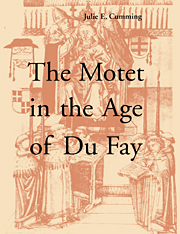Book contents
- Frontmatter
- Contents
- List of tables
- List of musical examples
- Acknowledgments
- Notes to the reader
- Introduction
- Part I Models and methods
- 1 Approaches and analogies
- 2 Subgenre, interpretation, and the generic repertory
- 3 Fifteenth-century uses of the term “motet”
- Part II Motets in the early fifteenth century: the case of Bologna Q15
- Part III Motets in the mid-fifteenth century: the case of the Trent Codices
- Conclusion
- Appendix: Widely disseminated motets
- Notes
- Bibliography of books and articles
- Modern editions of music
- Sources and sigla
- Notes on the index of works
- Abbreviations for subgenre identifications
- Index of works
- General index
2 - Subgenre, interpretation, and the generic repertory
Published online by Cambridge University Press: 22 September 2009
- Frontmatter
- Contents
- List of tables
- List of musical examples
- Acknowledgments
- Notes to the reader
- Introduction
- Part I Models and methods
- 1 Approaches and analogies
- 2 Subgenre, interpretation, and the generic repertory
- 3 Fifteenth-century uses of the term “motet”
- Part II Motets in the early fifteenth century: the case of Bologna Q15
- Part III Motets in the mid-fifteenth century: the case of the Trent Codices
- Conclusion
- Appendix: Widely disseminated motets
- Notes
- Bibliography of books and articles
- Modern editions of music
- Sources and sigla
- Notes on the index of works
- Abbreviations for subgenre identifications
- Index of works
- General index
Summary
Our look at category theory has provided us with tools for dealing with the problematic category of the motet and its many subgenres, while the evolutionary model can serve as a way of conceptualizing and explaining the massive changes in the motet over the course of the fifteenth century. But how does this framework help us to understand individual fifteenth-century motets? In this chapter I will suggest how knowledge of the motet's subgenres and history can help us to interpret individual works. I will also list some of the different kinds of generic features to be considered in classification and interpretation.
Genre, subgenre, and interpretation
As many critics have pointed out, genre and generic conventions make possible communication between the author and the reader or listener. Communication is only possible within a context in which the basic rules and guidelines are understood: these tell us what to pay attention to, what to ignore, and how to assemble the data as we progress through the work. Generic conventions provide such guidelines. A witty demonstration of this is provided by Heather Dubrow, who provides a hypothetical opening paragraph that could belong to either a mystery novel or a Bildungsroman: our reading strategies and interpretation of important details in this passage are very different depending on which we believe it is. In order to understand an individual work we need to develop a “horizon of expectation” (as Hans Robert Jauss puts it), against which to position the work.
- Type
- Chapter
- Information
- The Motet in the Age of Du Fay , pp. 24 - 40Publisher: Cambridge University PressPrint publication year: 1999



